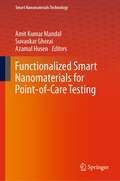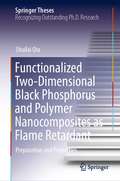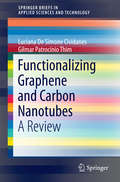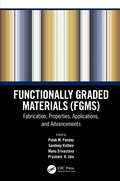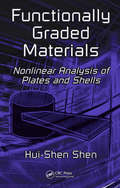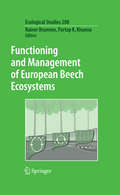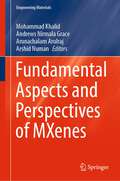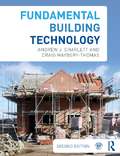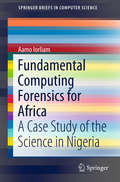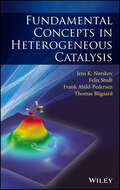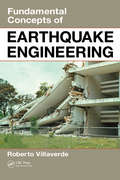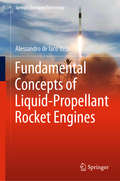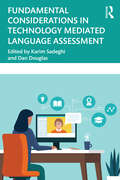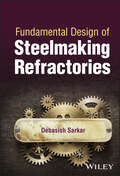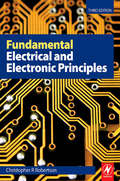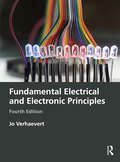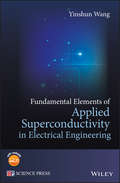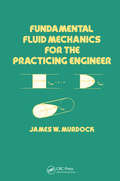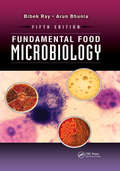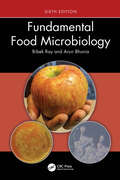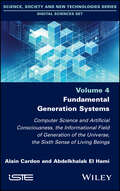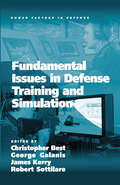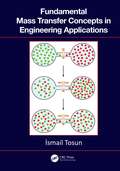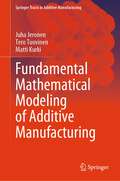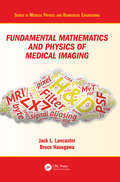- Table View
- List View
Functionalized Smart Nanomaterials for Point-of-Care Testing (Smart Nanomaterials Technology)
by Azamal Husen Amit Kumar Mandal Suvankar GhoraiThis book highlights the recent advancement in point-of-care testing (POCT) technologies utilizing ‘smart’ nanomaterials for the analysis of biomarkers related to disease, which includes metabolites, enzymes, proteins, nucleic acids, cancer cells and multidrug-resistant pathogen. The POCT refers to medical diagnostic tests performed near the place and time of patient care. During the recent pandemic of COVID-19, many realized the importance of affordable, rapid and accurate POCT devices and their usefulness to combat the spread of the infection. The chapters in this book describe the emergence of ‘smart’ nanomaterials with unique physical and chemical properties being utilized in POCT devices for immobilizing biorecognition elements and labels for signal generation, transduction and amplification. It showcases the applications of these smart nanomaterials and their superiority in developing point-of-care diagnostics devices in a wide range of applied fields like food industry, agriculture sector, water quality assessment, pharmaceuticals and tissue engineering. It also looks into the challenges associated and future direction of research in this promising field. This book caters as reference book for researches from the field of nanobiotechnology and biomedical sciences who are interested in the development of rapid, affordable and accurate POCT devices.
Functionalized Two-Dimensional Black Phosphorus and Polymer Nanocomposites as Flame Retardant: Preparation and Properties (Springer Theses)
by Shuilai QiuThis thesis details the novel preparation methods and the improved properties of two-dimentional (2D) black phosphorene (BP) and the polymer nanocomposites. Various surface treatment methods are used, and through these designs, better mechanical, thermal and flame retardant properties are achieved for these functionalized materials, thus reducing the fire risk of the polymer composite system.
Functionalizing Graphene and Carbon Nanotubes
by Filipe Vargas Ferreira Luciana De Simone Cividanes Felipe Sales Brito Beatriz Rossi Canuto Menezes Wesley Franceschi Evelyn Alves Nunes Simonetti Gilmar Patrocínio ThimThis book compiles all current information on the different types of functionalization of carbon nanotubes (CNTs) and graphene, both covalent and non-covalent. The book starts with a general overview of the synthesis, characterization and application of functionalized CNTs and graphene. Special attention is dedicated to the characterization of functionalized materials, a topic rarely addressed on the literature. The authors provide a comparison between the functionalization of these two types of carbon materials.
Functionally Graded Materials (FGMs): Fabrication, Properties, Applications, and Advancements
by Pulak M. Pandey, Sandeep Rathee, Manu Srivastava, and Prashant K. JainThe science and study of functionally graded materials (FGMs) have intrigued researchers over the last few decades. Their application has the capability to produce parts with unmatched properties which are virtually impossible to obtain via conventional material routes. This book addresses various FGM aspects and provides a relevant, high-quality, and comprehensive data source. The book covers trends, process classification on various bases, physical processes involved, structure, properties, applications, advantages, and limitations. Emerging trends in the field are discussed in detail and advancements are thoroughly reviewed and presented to broaden the spectrum of FGM applications. This reference book will be of interest to scholars, researchers, academicians, industry practitioners, government labs, libraries, and anyone interested in the area of materials engineering.
Functionally Graded Materials: Nonlinear Analysis of Plates and Shells
by Hui-Shen ShenPut a New Class of Structural Composites to UseReal Solutions for Predicting Load Initially designed as thermal barrier materials for aerospace applications and fusion reactors, functionally graded materials (FGMs) are now widely employed as structural components in extremely high-temperature environments. However, little information is commonly av
Functioning and Management of European Beech Ecosystems
by Rainer Brumme Partap K. KhannaThis volume compiles the results of long-term observations of site properties and ecosystem processes for three beech forests. Representing a spectrum of common beech forest sites in Central Europe, they receive similar atmospheric inputs and are growing under similar climatic conditions, but differ in their soil acidity. Significant differences were observed in the diversity and activities of fauna and microbes in these soils, which was the major driving variable for the nutrient cycling processes, growth patterns, greenhouse gas emissions and the C and N sequestration in these forests. Differences in N and C contents and cycling among the three beech sites represented three phases (quasi steady-state, accumulation and degradation) as described by ecosystem theory on the functioning and historical development of the N dynamic of other 50 European ecosystems. Various implications for the future management of these and similar beech sites are discussed.
Fundamental Aspects and Perspectives of MXenes (Engineering Materials)
by Mohammad Khalid Arshid Numan Andrews Nirmala Grace Arunachalam ArulrajThis book presents the fundamental aspects, recent developments in fabrication and characterization techniques, structure, properties, and emerging applications of MXenes. It shows the advancement in scale-up, challenges, and their futuristic perspectives. An overview of all the latest developments in energy storage and conversion applications, catalysis, environmental remediation, and radiation shielding, etc is reported.
Fundamental Building Technology
by Craig Maybery-Thomas Andrew J. CharlettFundamental Building Technology introduces the technology, methods, and processes fundamental to construction by focussing on what is involved in building a typical low-rise house. Written with the novice in mind, this textbook is the ideal starting point for any construction student, as it fully supports the reader all the way to understanding the functional requirements of each element of the building, and how to take these into account through the building process itself. This second edition is expanded to cover even more relevant topics, and is supported by more resources for use by the student and lecturer. Now included are: An introduction to the planning process and the building regulations How to incorporate a sustainable approach, in the selection of materials and elsewhere A companion site with lecturer's answers manual and illustrated lecture notes 150 labelled diagrams throughout the book, and multiple self-study questions in every chapter A students' section of the companion site with multiple choice quizzes and 250 full-colour photos linked to chapters of the book Concise, focussed and the most student-friendly guide to this topic available, Fundamental Building Technology is the perfect textbook for those taking construction technology modules at undergraduate or HNC/HND level.
Fundamental Computing Forensics for Africa: A Case Study of the Science in Nigeria (SpringerBriefs in Computer Science)
by Aamo IorliamThis book presents a general introduction to the computational aspects of forensic science, covering the different tools needed for forensic investigations, the importance of forensics and biometrics, and the use of Benford’s law for biometrics and network traffic analysis. It specifically focuses on the application of these techniques in Africa, and how they can be of benefit in the investigation of crime in Nigeria in particular.
Fundamental Concepts in Heterogeneous Catalysis
by Thomas Bligaard Jens K. Nørskov Felix Studt Frank Abild-PedersenThis book is based on a graduate course and suitable as a primer for any newcomer to the field, this book is a detailed introduction to the experimental and computational methods that are used to study how solid surfaces act as catalysts. Features include: First comprehensive description of modern theory of heterogeneous catalysis Basis for understanding and designing experiments in the field Allows reader to understand catalyst design principles Introduction to important elements of energy transformation technology Test driven at Stanford University over several semesters
Fundamental Concepts of Earthquake Engineering
by Roberto VillaverdeWhile successfully preventing earthquakes may still be beyond the capacity of modern engineering, the ability to mitigate damages with strong structural designs and other mitigation measures are well within the purview of science. Fundamental Concepts of Earthquake Engineering presents the concepts, procedures, and code provisions that are currentl
Fundamental Concepts of Liquid-Propellant Rocket Engines (Springer Aerospace Technology)
by Alessandro de Iaco VerisThis book is intended for students and engineers who design and develop liquid-propellant rocket engines, offering them a guide to the theory and practice alike. It first presents the fundamental concepts (the generation of thrust, the gas flow through the combustion chamber and the nozzle, the liquid propellants used, and the combustion process) and then qualitatively and quantitatively describes the principal components involved (the combustion chamber, nozzle, feed systems, control systems, valves, propellant tanks, and interconnecting elements). The book includes extensive data on existing engines, typical values for design parameters, and worked-out examples of how the concepts discussed can be applied, helping readers integrate them in their own work. Detailed bibliographical references (including books, articles, and items from the “gray literature”) are provided at the end of each chapter, together with information on valuable resources that can be found online. Given its scope, the book will be of particular interest to undergraduate and graduate students of aerospace engineering.
Fundamental Considerations in Technology Mediated Language Assessment
by Karim Sadeghi and Dan DouglasFundamental Considerations in Technology Mediated Language Assessment aims to address issues such as how the forced integration of technology into second language assessment has shaped our understanding of key traditional concepts like validity, reliability, washback, authenticity, ethics, fairness, test security, and more. Although computer assisted language testing has been around for more than two decades in the context of high-stakes proficiency testing, much of language testing worldwide has shifted to 'at home' mode, and relies heavily on the mediation of digital technology, making its widespread application in classroom settings in response to the COVID-19 outbreak as unprecedented. Integration of technology into language assessment has brought with it countless affordances and at the same time challenges, both theoretically and practically. One major theoretical consideration requiring attention is the way technology has contributed to a re-conceptualisation of major assessment concepts/constructs. There is very limited literature available on theoretical underpinnings of technology mediated language assessment. This book aims to fill this gap. This book will appeal to academic specialists, practitioners or professionals in the field of language assessment, advanced and/or graduate students, and a range of scholars or professionals in disciplines like educational technology, applied linguistics and TESOL.
Fundamental Design of Steelmaking Refractories
by Debasish SarkarFundamental Design of Steelmaking Refractories Comprehensive up-to-date resource organizing fundamental aspects for the design and performance of steelmaking refractories Fundamental Design of Steelmaking Refractories provides a fundamental understanding in the design of steelmaking refractories, in detail and all in one source, enabling readers to understand various issues including how heat and mass transfer occurs throughout the refractory, how matrix impurity or their contact affects the phases, and how invisible defects form during refractory manufacturing that eventually facilitates to analyze wear, corrosion, and performance of different refractory linings for primary and secondary steelmaking vessels, tundish, and continuous casting refractories. Other specific sample topics covered in Fundamental Design of Steelmaking Refractories include: Phase formations and correlation with impurity effects and refractory processing shortcomings Stress, wear, and corrosion to design refractories and performance statistics of steelmaking refractories Equilibrium and non-equilibrium phases, packing, stress and defects in compaction, and degree of ceramic bonding Thermal and mechanical behavior, flow control mechanisms, continuous casting refractories, and premature refractory damage Precast and purging system, consistent supply and time management, and preventive maintenance in operation With its complete coverage of the subject, Fundamental Design of Steelmaking Refractories fulfills the academic demand of undergraduate, postgraduate, and research scholars of ceramic engineering; metallurgical engineers and mechanical engineering outlets that want to nurture in the refractory and steel sectors will also find value in the text.
Fundamental Electrical and Electronic Principles
by C R RobertsonFundamental Electrical and Electronic Principles covers the essential principles that form the foundations for electrical and electronic engineering courses. The coverage of this new edition has been carefully brought in line with the core unit 'Electrical and Electronic Principles' of the 2007 BTEC National Engineering specification from Edexcel. As the book follows a logical topic progression rather than a particular syllabus, it is also suitable for other Level 3 students on vocational courses such as Vocational AS/A Level, City & Guilds courses and NVQs, as well as those taking foundation courses at pre-degree level including HNC/HND.Each chapter starts with learning outcomes tied to the syllabus. All theory is explained in detail and backed up with numerous worked examples. Students can test their understanding with end of chapter assignment questions for which answers are provided. The book also includes suggested practical assignments and handy summaries of equations. In this new edition, the layout has been improved and colour has been added to make the book more accessible for students.The textbook is supported with a free companion website featuring supplementary worked examples and additional chapters.http://books.elsevier.com/companions/9780750687379
Fundamental Electrical and Electronic Principles
by Jo VerhaevertFundamental Electrical and Electronic Principles covers the essential principles that form the foundations for electrical and electronic engineering courses. This new edition is extensively updated with a greater focus on electronic principles, evenly balanced with electrical principles. Fuller coverage is given to active electronics, with the additional topics of diodes and transistors, and core topics such as oscilloscopes now reflect state-of-the-art technology.Each main chapter starts with learning outcomes tied to the syllabus. All theory is explained in detail and backed up with numerous worked examples and handy summaries of equations. Students can test their understanding with end-of-chapter assignment questions for which answers are provided. The book also provides detailed suggested practical assignments outlining apparatus and methods.The book forms an excellent core work for beginning further education students with some mathematics background preparing for careers as technicians, and an introductory text for first-year undergraduate students in all engineering disciplines.
Fundamental Elements of Applied Superconductivity in Electrical Engineering, 1st Edition
by Yinshun WangSuperconducting technology is potentially important as one of the future smart grid technologies. It is a combination of superconductor materials, electrical engineering, cryogenic insulation, cryogenics and cryostats. There has been no specific book fully describing this branch of science and technology in electrical engineering. However, this book includes these areas, and is essential for those majoring in applied superconductivity in electrical engineering. Recently, superconducting technology has made great progress. Many universities and companies are involved in applied superconductivity with the support of government. Over the next five years, departments of electrical engineering in universities and companies will become more involved in this area. This book: * will enable people to directly carry out research on applied superconductivity in electrical engineering * is more comprehensive and practical when compared to other advances * presents a clear introduction to the application of superconductor in electrical engineering and related fundamental technologies * arms readers with the technological aspects of superconductivity required to produce a machine * covers power supplying technologies in superconducting electric apparatus * is well organized and adaptable for students, lecturers, researchers and engineers * lecture slides suitable for lecturers available on the Wiley Companion Website Fundamental Elements of Applied Superconductivity in Electrical Engineering is ideal for academic researchers, graduates and undergraduate students in electrical engineering. It is also an excellent reference work for superconducting device researchers and engineers.
Fundamental Fluid Mechanics for the Practicing Engineer (Mechanical Engineering)
by James W. MurdockA step-by-step guide, containing tutorial examples that serve as models for all concepts presented. This text contains properties of nearly 50 fluids, including density and viscosity data for compressed water and superheated steam, and characteristics of areas, pipes and tubing.
Fundamental Food Microbiology
by Bibek Ray Arun BhuniaThe golden era of food microbiology has begun. All three areas of food microbiology-beneficial, spoilage, and pathogenic microbiology-are expanding and progressing at an incredible pace. What was once a simple process of counting colonies has become a sophisticated process of sequencing complete genomes of starter cultures and use of biosensors to
Fundamental Food Microbiology
by Bibek Ray Arun BhuniaFood microbiology has seen enormous growth in the last decade, fueled by the global pandemic of COVID-19 and continual routine outbreaks with traditional foodborne pathogens. In addition, climate change and global warming also affect agriculture and food production, in turn shifting microbial ecology. Such changes will affect pathogen behavior, spoilage, and microbial growth, impacting food safety and quality. Health-conscious consumers are also looking for foods with alternative protein sources from plants and insects, such as fermented, antioxidant, and micronutrient-rich superfoods. All three areas of food microbiology—beneficial, spoilage, and pathogenic microbiology—are expanding and progressing incredibly. What was once a simple process of counting colonies has become a sophisticated process of sequencing complete genomes, gene editing, and biotechnology for starter cultures and probiotics improvement and application of sophisticated analytical tools for microbial analysis.Fundamental Food Microbiology, Sixth Edition captures these developments and broadens coverage of foodborne disease mechanisms, spoilage microbes, and microbial inactivation strategies. Written by experts with approximately sixty years of combined experience, the book provides an in-depth understanding of how to reduce microbial food spoilage, improve intervention technologies, and develop effective control methods for different types of foods.See What’s New in the Sixth Edition Condensed chapter descriptions with illustrations CRISPR/Cas system for gene editing Novel food processing technologies, including plasma and micro/nanobubble technologies Food radiation and hurdle concept chapters are merged and overhauled Comprehensive list of mycotoxins and seafood-related toxins Updates on several new antimicrobial compounds from animal and plant sources Maintaining the high standard set by the previous bestselling editions, and based on feedback from students and professors, this new edition includes even more easy-to-follow figures and illustrations. The chapters are presented logically, connecting the information and allowing students to understand and retain the concepts presented easily. These features make this a comprehensive introductory text for undergraduates and a valuable reference for graduate-level and working professionals in food microbiology, food safety, or food technology.
Fundamental Generation Systems: Computer Science and Artificial Consciousness, the Informational Field of Generation of the Universe, the Sixth Sense of Living Beings
by Alain Cardon Abdelkhalak El HamiThere are many different ways of generating representations. This includes representations generated by living beings while comprehending reality in order to act; representations generated by the Universe during its extensive unfolding, creating physical elements and living beings; and the direct representation of elements through an animal’s sixth sense. To this list we must now add the creation of artificial consciousness, which generates representations that resemble the mental representations of humans. These representations allow robotic systems to communicate directly with each other.Fundamental Generation Systems develops a theory which presents, from the beginning, the function of this sixth sense called the “sense of informational comprehension”. This sense is understood as an ability to use the informational foundations of the Universe via a dedicated cerebral domain found in every animal.
Fundamental Issues in Defense Training and Simulation (Human Factors in Defence)
by George Galanis Robert SottilareDefense forces have always invested a great deal of their resources in training. In recent times, changes in the complexity and intensity of operations have reaffirmed the importance of ensuring that warfighters are adequately prepared for the environments in which they are required to work. The emergence of new operational drivers such as asymmetric threats, urban operations, joint and coalition operations and the widespread use of military communications and information technology networks has highlighted the importance of providing warfighters with the competencies required to act in a coordinated, adaptable fashion, and to make effective decisions in environments characterized by large amounts of sometimes ambiguous information. While investment in new technologies can make available new opportunities for action, it is only through effective training that personnel can be made ready to apply their tools in the most decisive and discriminating fashion. There are many factors which can have an impact on the efficacy of training and many issues to consider when designing and implementing training strategies. These issues are often complex and nuanced, and in order to grasp them fully a significant investment of time and energy is required. However, the requirement to respond quickly to ever-changing technology, a high operational tempo and minimal staffing may preclude many in today's defense forces from seeking out all such resources on their own. This edited collection provides brief, easy-to-understand summaries of the key issues in defense training and simulation, as well as guidance for further reading. It consists of a collection of short essays, each of which addresses a fundamental issue in defense training and simulation, and features an up-to-date reference list to enable the reader to undertake further investigation of the issues addressed. In essence, this book provides the optimum starting point, or first resource, for readers to come to terms with the important issues associated with defense training and simulation. The contributions are written by leading scholars from military research institutions in the US, UK, Canada, Australia and New Zealand, as well as selected researchers from academic and private sector research institutions.
Fundamental Mass Transfer Concepts in Engineering Applications
by Ismail TosunFundamental Mass Transfer Concepts in Engineering Applications provides the basic principles of mass transfer to upper undergraduate and graduate students from different disciplines. This book outlines foundational material and equips students with sufficient mathematical skills to tackle various engineering problems with confidence. It covers mass transfer in both binary and multicomponent systems and integrates the use of Mathcad® for solving problems. This textbook is an ideal resource for a one-semester course. Key Features The concepts are explained with the utmost clarity in simple and elegant language Presents theory followed by a variety of practical, fully-worked example problems Includes a summary of the mathematics necessary for mass transfer calculations in an appendix Provides ancillary Mathcad® subroutines Includes end-of-chapter problems and a solutions manual for adopting instructors
Fundamental Mathematical Modeling of Additive Manufacturing (Springer Tracts in Additive Manufacturing)
by Juha Jeronen Tero Tuovinen Matti KurkiThis book elucidates the fundamental thermomechanical behaviour inherent in the 3D printing process within a laser-based powder bed fusion (L-PBF) system. It presents foundational concepts and provides in-depth derivations of the governing equations. The analysis encompasses arbitrary anisotropic linear viscoelastic materials, accounting for thermal effects. The authors leverage the theory of axially moving materials, a framework previously employed in the analysis of production processes within the process industry. They introduce a coordinate frame that moves in tandem with the printing laser, adopting an Eulerian perspective towards the in-motion solid. Designed for graduate students and researchers, this book is poised to foster a profound comprehension and spur innovative technological advancements in the realm of additive manufacturing.
Fundamental Mathematics and Physics of Medical Imaging (Series in Medical Physics and Biomedical Engineering)
by Jack Lancaster Bruce HasegawaAuthored by a leading educator, this book teaches the fundamental mathematics and physics concepts associated with medical imaging systems. Going beyond mere description of imaging modalities, this book delves into the mechanisms of image formation and image quality common to all imaging systems: contrast mechanisms, noise, and spatial and temporal resolution, making it an important reference for medical physicists and biomedical engineering students. This is an extensively revised new edition of The Physics of Medical X-Ray Imaging by Bruce Hasegawa (Medical Physics Publishing, 1991), and includes a wide range of modalities such as X-ray CT, MRI and SPECT.
